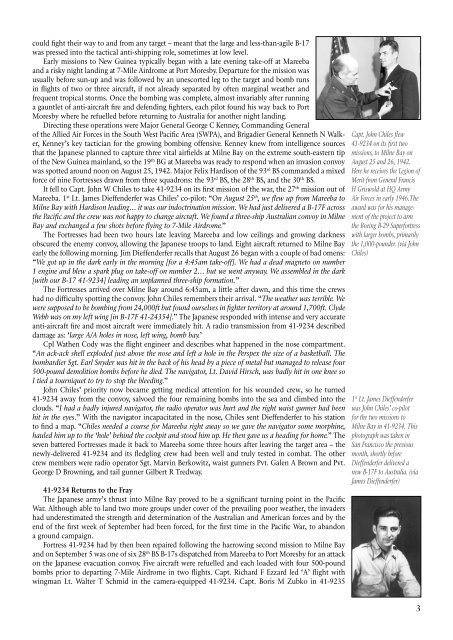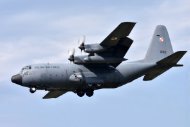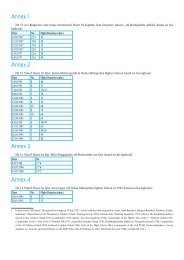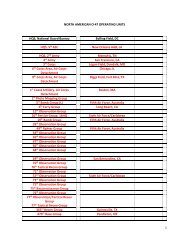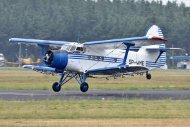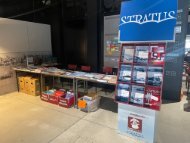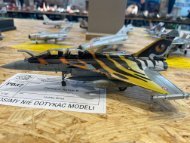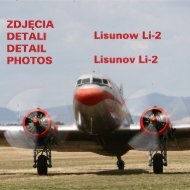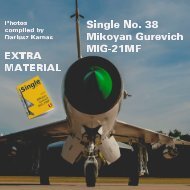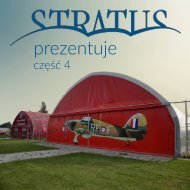B-17 CC Additional Material by Robert M Stitt
Boeing B-17 Fortress in RAF Coastal Command Service Second Edition Robert M Stitt Additional Material
Boeing B-17 Fortress in RAF Coastal Command Service
Second Edition
Robert M Stitt
Additional Material
- No tags were found...
Create successful ePaper yourself
Turn your PDF publications into a flip-book with our unique Google optimized e-Paper software.
could fight their way to and from any target – meant that the large and less-than-agile B-<strong>17</strong><br />
was pressed into the tactical anti-shipping role, sometimes at low level.<br />
Early missions to New Guinea typically began with a late evening take-off at Mareeba<br />
and a risky night landing at 7-Mile Airdrome at Port Mores<strong>by</strong>. Departure for the mission was<br />
usually before sun-up and was followed <strong>by</strong> an unescorted leg to the target and bomb runs<br />
in flights of two or three aircraft, if not already separated <strong>by</strong> often marginal weather and<br />
frequent tropical storms. Once the bombing was complete, almost invariably after running<br />
a gauntlet of anti-aircraft fire and defending fighters, each pilot found his way back to Port<br />
Mores<strong>by</strong> where he refuelled before returning to Australia for another night landing.<br />
Directing these operations were Major General George C Kenney, Commanding General<br />
of the Allied Air Forces in the South West Pacific Area (SWPA), and Brigadier General Kenneth N Walker,<br />
Kenney’s key tactician for the growing bombing offensive. Kenney knew from intelligence sources<br />
that the Japanese planned to capture three vital airfields at Milne Bay on the extreme south-eastern tip<br />
of the New Guinea mainland, so the 19 th BG at Mareeba was ready to respond when an invasion convoy<br />
was spotted around noon on August 25, 1942. Major Felix Hardison of the 93 rd BS commanded a mixed<br />
force of nine Fortresses drawn from three squadrons: the 93 rd BS, the 28 th BS, and the 30 th BS.<br />
It fell to Capt. John W Chiles to take 41-9234 on its first mission of the war, the 27 th mission out of<br />
Mareeba. 1 st Lt. James Dieffenderfer was Chiles’ co-pilot: “On August 25 th , we flew up from Mareeba to<br />
Milne Bay with Hardison leading… it was our indoctrination mission. We had just delivered a B-<strong>17</strong>F across<br />
the Pacific and the crew was not happy to change aircraft. We found a three-ship Australian convoy in Milne<br />
Bay and exchanged a few shots before flying to 7-Mile Airdrome.”<br />
The Fortresses had been two hours late leaving Mareeba and low ceilings and growing darkness<br />
obscured the enemy convoy, allowing the Japanese troops to land. Eight aircraft returned to Milne Bay<br />
early the following morning. Jim Dieffenderfer recalls that August 26 began with a couple of bad omens:<br />
“We got up in the dark early in the morning [for a 4:45am take-off]. We had a dead magneto on number<br />
1 engine and blew a spark plug on take-off on number 2… but we went anyway. We assembled in the dark<br />
[with our B-<strong>17</strong> 41-9234] leading an unplanned three-ship formation.”<br />
The Fortresses arrived over Milne Bay around 6:45am, a little after dawn, and this time the crews<br />
had no difficulty spotting the convoy. John Chiles remembers their arrival. “The weather was terrible. We<br />
were supposed to be bombing from 24,000ft but found ourselves in fighter territory at around 1,700ft. Clyde<br />
Webb was on my left wing [in B-<strong>17</strong>F 41-24354].” The Japanese responded with intense and very accurate<br />
anti-aircraft fire and most aircraft were immediately hit. A radio transmission from 41-9234 described<br />
damage as: ‘large A/A holes in nose, left wing, bomb bay.’<br />
Cpl Wathen Cody was the flight engineer and describes what happened in the nose compartment.<br />
“An ack-ack shell exploded just above the nose and left a hole in the Perspex the size of a basketball. The<br />
bombardier Sgt. Earl Snyder was hit in the back of his head <strong>by</strong> a piece of metal but managed to release four<br />
500-pound demolition bombs before he died. The navigator, Lt. David Hirsch, was badly hit in one knee so<br />
I tied a tourniquet to try to stop the bleeding.”<br />
John Chiles’ priority now became getting medical attention for his wounded crew, so he turned<br />
41-9234 away from the convoy, salvoed the four remaining bombs into the sea and climbed into the<br />
clouds. “I had a badly injured navigator, the radio operator was hurt and the right waist gunner had been<br />
hit in the eyes.” With the navigator incapacitated in the nose, Chiles sent Dieffenderfer to his station<br />
to find a map. “Chiles needed a course for Mareeba right away so we gave the navigator some morphine,<br />
hauled him up to the ‘hole’ behind the cockpit and stood him up. He then gave us a heading for home.” The<br />
seven battered Fortresses made it back to Mareeba some three hours after leaving the target area – the<br />
newly-delivered 41-9234 and its fledgling crew had been well and truly tested in combat. The other<br />
crew members were radio operator Sgt. Marvin Berkowitz, waist gunners Pvt. Galen A Brown and Pvt.<br />
George D Browning, and tail gunner Gilbert R Tredway.<br />
41-9234 Returns to the Fray<br />
The Japanese army’s thrust into Milne Bay proved to be a significant turning point in the Pacific<br />
War. Although able to land two more groups under cover of the prevailing poor weather, the invaders<br />
had underestimated the strength and determination of the Australian and American forces and <strong>by</strong> the<br />
end of the first week of September had been forced, for the first time in the Pacific War, to abandon<br />
a ground campaign.<br />
Fortress 41-9234 had <strong>by</strong> then been repaired following the harrowing second mission to Milne Bay<br />
and on September 5 was one of six 28 th BS B-<strong>17</strong>s dispatched from Mareeba to Port Mores<strong>by</strong> for an attack<br />
on the Japanese evacuation convoy. Five aircraft were refuelled and each loaded with four 500-pound<br />
bombs prior to departing 7-Mile Airdrome in two flights. Capt. Richard F Ezzard led ‘A’ flight with<br />
wingman Lt. Walter T Schmid in the camera-equipped 41-9234. Capt. Boris M Zubko in 41-9235<br />
Capt. John Chiles flew<br />
41-9234 on its first two<br />
missions, to Milne Bay on<br />
August 25 and 26, 1942.<br />
Here he receives the Legion of<br />
Merit from General Francis<br />
H Griswold at HQ Army<br />
Air Forces in early 1946.The<br />
award was for his management<br />
of the project to arm<br />
the Boeing B-29 Superfortress<br />
with larger bombs, primarily<br />
the 1,000-pounder. (via John<br />
Chiles)<br />
1 st Lt. James Dieffenderfer<br />
was John Chiles’ co-pilot<br />
for the two missions to<br />
Milne Bay in 41-9234. This<br />
photograph was taken in<br />
San Francisco the previous<br />
month, shortly before<br />
Dieffenderfer delivered a<br />
new B-<strong>17</strong>F to Australia. (via<br />
James Dieffenderfer)<br />
3


